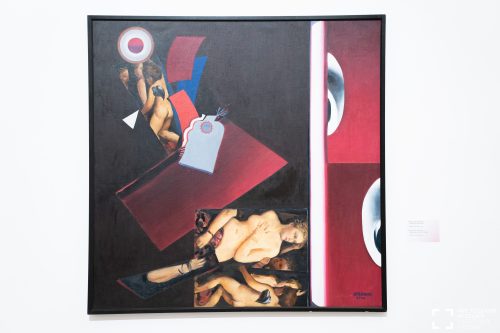Decomposition of CodesExhibitions
-
-
Search for an exhibition
-
- Search
Name
Decomposition of Codes
Author
Oleksandr Dubovyk
Date of creation
2003
Material
Oil on canvas
Oleksandr Dubovyk (born 1931, Kyiv) is a Ukrainian painter, graphic artist and monumentalist, author of mosaics and stained glass. The son of Mykhailo Dubovyk, a Ukrainian poet, a member of the literature association “Pluh” (“Plow”), who was sentenced to death by shooting in 1941, accused of counterrevolutionary activities.
He is a representative of the unofficial art of the Soviet era. In 1957, he graduated from the Kyiv Art Institute with a degree in Painting, where his mentors were Serhii Hrihoriev, Gennady Tytov and Mykhaylo Khmelko. Then, from 1962 to 1965, he was a postgraduate student at the creative workshops of the Academy of Arts of the USSR in Kyiv, Serhii Hrihoriev being his supervisor. His early works tended to have the severe stylistics of the 1960s. In 1966, he painted Bouquet which, compared to the cognominal painting from the previous year, obtained the shape of a sign that would occupy a prominent place in the figurative semantic structure of the artist’s philosophy. And in his self-portrait of 1967, the traditional figurative language is replaced by the universal timeless language of signs. In the 1970s, the artist developed his own image-plastic system of painting, which combines interpretations of Suprematism, late Cubism, geometric abstractions, the traditions of icon painting, and the avant-garde of the 1920s, and he revealed a fundamental pictorial composition scheme that would become a core of most of his paintings. The author himself defined the phenomenon of his non-figurative painting with the term “suggestive realism”.
Explicit development of his art led to the conflict with the functionaries of the Artists’ Union of the USSR. As a result, Dubovyk’s art works were banned from being exhibited for nearly two decades. In the 1980s, Oleksandr Dubovyk made a series of monumental-decorative artworks in Ukraine as well as abroad, he created a series of gouache works that thematically continued the series of oil works, and was actively exhibited again. In the early 2000s, he declared the new, postmodernist period in his creative activities. In 2008, he created his own artistic manifestos — The Black Bouquet and The Red Bouquet, wherein the symbolic sign is contained within the white plain of the canvas in the form of a circle that embodies the spiritual world, and in the form of a triangle that symbolizes a human being. In recent years, the idea of Bouquet has grown into a certain concept that is being explored by the author in a visual series of new works and extensive texts. “The White Bouquet,” says Oleksandr Dubovyk, “is a powerful symbol that combines in itself many subjects, epochs, styles, conventions, and psychological attitudes as an equal component of many realities in many dimensions.”
According to Jean-Claude Marcadé, a famous French art historian, Dubovyk’s work belongs to the abstract symbolic trend, which creates an individual vocabulary of signs, hieroglyphs, pictograms and ideograms, and embodies them in architectural constructions, musical variations, and poetic parables. In this respect, Dubovyk’s art, because of the synthetic combination of rhythms of various arts in it, is very close to Gesamtkunstwerk (a term of the German philosopher and theologian Karl Friedrich Trandorff, meaning a synthesis of various arts together with science, philosophy and religion). The artist gives each of us a worldly blooming of a magical sacred ceremony.

